| Article ID | Journal | Published Year | Pages | File Type |
|---|---|---|---|---|
| 4730095 | Journal of Asian Earth Sciences | 2016 | 22 Pages |
•Synopsis of the large and unique uranium-ore belts in cratonic domains of East Asia.•Impact of mantle dynamics on ore genesis.•Metallogenic characterization based on location of subducted slabs.
Some of the largest uranium orebelts and deposits of Asia occur in Southeast Russia and East Mongolia. In Russia, the Elkon and Streltsovka belts are located in the Aldan (South Yakutia) and Urulyungui (Southeast Trans-Baikal area) districts, covering a distance of more than 1200 km. The superlarge Dornod deposit occurs in the North Choibalsan district of East Mongolia, ca. 300 km to the southwest of Streltsovka. These uranium occurrences are distributed in the Central Aldan and Kerulen-Argun cratonic domains, separated by the Selenga–Stanovoi (Yenisei-Trans-Baikal) and Mongol–Okhotsk orogenic belts. A synthesis of the characteristics and the timing of mineralization suggest that all of these occurrences were generated synchronously. Seismic tomography data show that these deposits are mostly located above the frontal part of a stagnant oceanic slab. We envisage that slab dehydration and influx of fluids into the asthenospheric mantle and their subsequent interaction with the lithosphere aided the localization of these unique-scale uranium concentrations.
Graphical abstractFigure optionsDownload full-size imageDownload as PowerPoint slide
